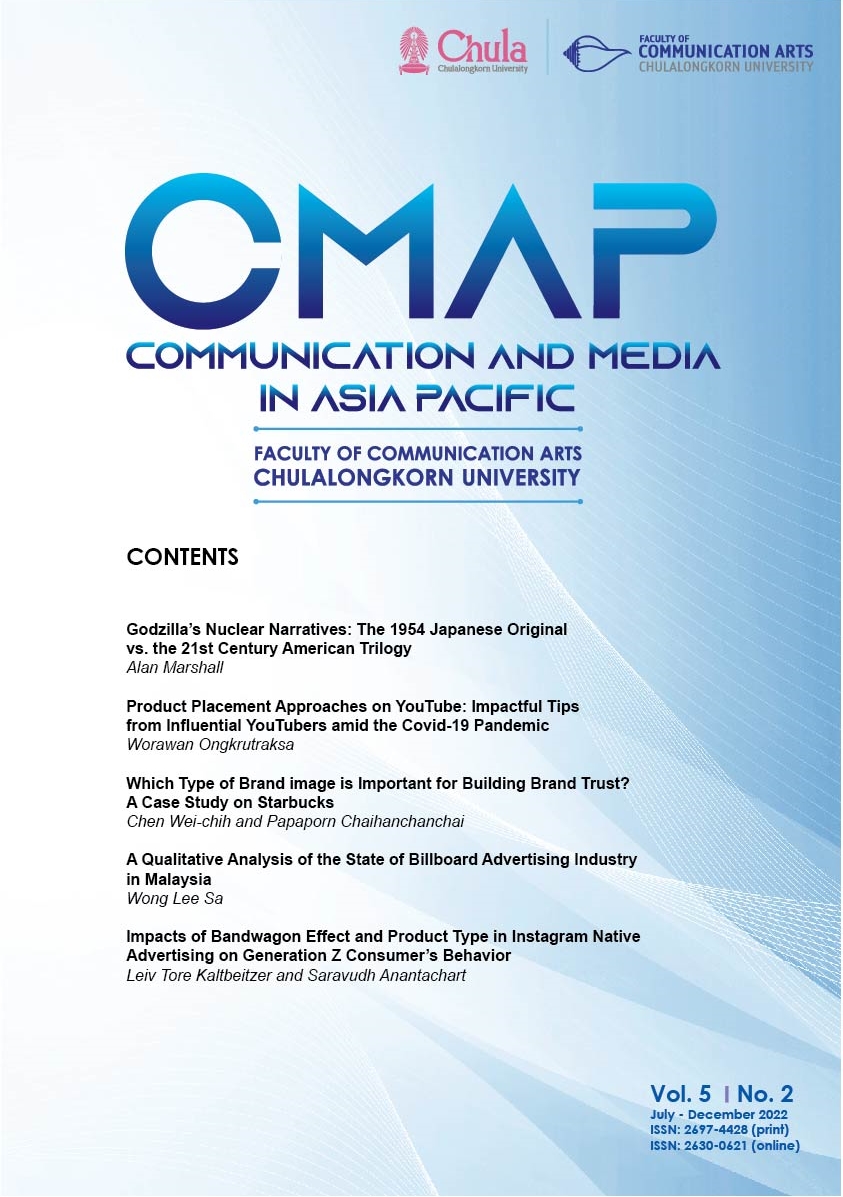Product Placement Approaches on YouTube: Impactful Tips from Influential YouTubers amid the Covid-19 Pandemic
Main Article Content
Abstract
Amid the Covid-19 pandemic in 2021, Thai audiences tended to develop more bonds with, and thus dependency on, YouTube platform. This paper aims to explore YouTubers’ adoption of the product-placement advertising approach and investigate the impactful tips that work for “product placement” on YouTube amid the Covid-19 pandemic, as shared through in-depth interviews by four influential YouTubers. Important recommended tactics for product placement in YouTubers’ channels are:1) select advertised products/services based on compatibility with their contents, 2) emphasize honesty toward their viewers, 3) aware of all sorts of negativity, 4) beware of producing or presenting contents that could potentially violate existing laws or rules, 5) attend to content details that may affect their viewers, 6) express the care and caveat on environmental issues, and 7) be careful in offering comments or providing feedback that might drive a wedge between contentious interest groups. In sum, Harmonic Communication is a three-step Harmonic approach to improving the credibility of product-placement advertising via YouTube programs and channels. Moreover, a surge in online usage of advertising media following consumer-mobility restrictions during the Covid-19 pandemic has necessitated effective regulatory interventions.
Article Details
References
Budiono, T., & Triyono, A. (2020). YouTube Endorsement and changes in the Web 2.0's Advertising Industry. Jurnal ASPIKOM, 5(2), 338-351.
Cho, C.-H. (2004). Why do people avoid advertising on the internet? Journal of Advertising, 33(4), 89-97.
Dewan, L. (2021). The surprising ways COVID-19 changed consumer behavior. Retrieved from https://adage.com/article/healthline/surprising-ways-covid-19-changed-consumer-behavior/2347231
Electronic Transactions Development Agency. (2021). Internet users in Thailand. Retrieved from https://www.etda.or.th/getattachment/
Kok, M. (2021). Too many product placements? What factors explain the behavior of internet users towards product placement on YouTube? Retrieved from http://hdl.handle.net/2078.1/thesis:31228
Matter. (2021). The results of the 2021 viewing survey found that content in finance, karaoke and self-development are strong. Retrieved from https://thematter.co/brief/15552/156115
Ongkrutraksa, W. (2019). Marketing communications in YouTube and the influences on consumers’ behavior [Research report]. Bangkok, Thailand: Faculty of Communication Arts. Chulalongkorn University.
Ongkrutraksa, W. (2021a). The analysis of child YouTubers’ videos in Thailand to develop appropriate YouTube advertising. AU eJournal of Interdisciplinary Research, 6(2), 34-41.
Ongkrutraksa, W. (2021b). Marketing communications in YouTube and the influences on consumers’ behavior after Covid-19 pandemic. [Research report]. Bangkok, Thailand: Faculty of Communication Arts. Chulalongkorn University.
Ongkrutraksa, W. (2022). Exploring young consumers’ exposure, attitude, and behavioral response to YouTube video game streaming’s product placement. International Journal of Electronic Commerce Studies, 13(3), 45-68.
prmatter. (2022). A survey of Thai consumers in 2022 after Covid-19. Retrieved from https://www.prmatter.com/
Punnasub, C. (2018). YouTuber personal branding strategies and perspectives of Thai millenial toward YouTubers [Unplublished master's thesis]. Chulalongkorn University, Thailand.
Russell, C. A. (2007). Advertainment: Fusing advertising and entertainment. Ann Arbor, MI: University of Michigan Yaffe Center for Persuasive Communication.
Russell, C. A. (2019). Expanding the agenda of research on product placement: A commercial intertext. Journal of Advertising, 48(1), 38-48.
Sritiaphet, P. (2021). Legal perspectives on the case of information technology development and the changing of consumer behavior. Bangkok, Thailand: Unpublished report.
Thinkwithgoogle. (2021). Video ad formats. Retrieved from https://www.thinkwithgoogle.com/marketing-strategies/video/youtube-video-ad-formats/
Tybussek, N. (2020). Exploring young audiences’ engagement with "green" content on YouTube: A small qualitative study [Unplublished master's thesis]. Jönköping University, Sweden.
Uparimart, C. (2018). Measuring the influence of YouTube advertising in creating attractiveness to consumer in Bangkok, Thailand. International Research E-Journal on Business and Economics, 4(1), 19-38.
Vanover, C., Mihas, P., & Saldana, J. (Eds.). (2021). Analyzing and interpreting qualitative research: After the interview. Thousand Oaks, CA: Sage.
Wisankosol, P. (2021). YouTube secrets: Critical success factors for youtubers in Thailand. Journal of Global Business Review, 23(1), 76-90.
Wu, K. (2016). YouTube marketing: Legality of sponsorship and endorsement in advertising. Journal of Law, Business, and Ethics, 22, 59-91.


